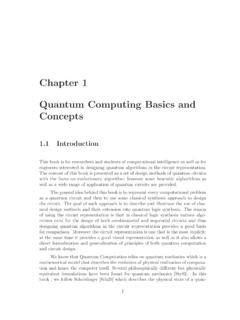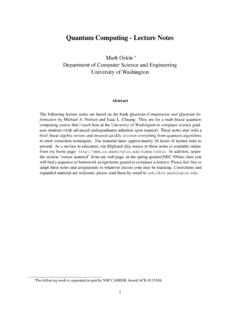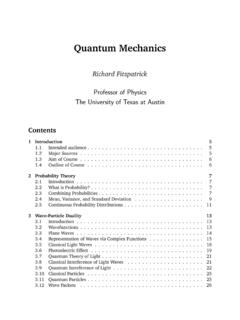Transcription of QUANTUM FIELD THEORY – 230A
1 QUANTUM FIELD THEORY 230 AEric D HokerDepartment of Physics and AstronomyUniversity of California, Los Angeles, CA 900952004, October 3 Contents1 Relativity and QUANTUM mechanics .. Why QUANTUM FIELD THEORY ? .. Further conceptual changes required by relativity .. Some History and present significance of QFT .. 82 QUANTUM Mechanics A Classical Mechanics .. Principles of QUANTUM Mechanics .. QUANTUM Systems from classical mechanics .. QUANTUM systems associated with Lie algebras .. Appendix I : Lie groups, Lie algebras, representations .. Functional integral formulation .. 193 Principles of Relativistic QUANTUM FIELD The Lorentz and Poincar e groups and algebras.
2 Parity and time reversal .. Finite-dimensional Representations of the Lorentz Algebra .. Unitary Representations of the Poincar e Algebra .. The basic principles of QUANTUM FIELD THEORY .. Transformation of Local Fields under the Lorentz Group .. Discrete Symmetries .. Parity .. time reversal .. Charge Conjugation .. Significance of fields in terms of particle contents .. Classical Poincar e invariant FIELD theories .. 414 Free FIELD The Scalar FIELD .. The Operator Product Expansion & Composite Operators .. The Gauge or Spin 1 FIELD .. The Casimir Effect on parallel plates .. Bose-Einstein and Fermi-Dirac statistics.
3 The Spin 1/2 FIELD .. The Weyl basis and Free Weyl spinors .. The spin statistics theorem .. Parastatistics ? .. Commutation versus anti-commutation relations .. 725 Interacting FIELD Theories Gauge Interacting Lagrangians .. Abelian Gauge Invariance .. Non-Abelian Gauge Invariance .. Component formulation .. Bianchi identities .. Gauge invariant combinations .. Classical Action & FIELD equations .. Lagrangians including fermions and scalars .. Examples .. 806 The S-matrix and LSZ Reduction In and Out States and Fields .. The S-matrix .. Scattering cross sections .. Relating the interacting and in- and out-fields.
4 The K allen-Lehmann spectral representation .. The Dirac FIELD .. The LSZ Reduction Formalism .. In- and Out-Operators in terms of the free FIELD .. Asymptotics of the interacting FIELD .. The reduction formulas .. The Dirac FIELD .. The Photon FIELD .. 9421 IntroductionQuantum FIELD THEORY (abbreviated QFT) deals with the quantization of fields. A familiarexample of a FIELD is provided by the electromagnetic FIELD . Classical electromagnetismdescribes the dynamics of electric charges and currents, aswell as electro-magnetic waves,such as radio waves and light, in terms of Maxwell s equations. At the atomic level,however, the QUANTUM nature of atoms as well as the QUANTUM nature of electromagneticradiation must be taken into account.
5 QUANTUM mechanically, electromagnetic waves turnout to be composed of quanta of light, whose individual behavior is closer to that of aparticle than to a wave. Remarkably, the quantization of theelectromagnetic FIELD is interms of the quanta of this FIELD , which are particles, also calledphotons. In QFT, thisfield particle correspondence is used both ways, and it is oneof the key assumptions ofQFT that to every elementary particle, there corresponds a FIELD . Thus, the electron willhave its own FIELD , and so will every FIELD THEORY provides an elaborate general formalism for the FIELD particlecorrespondence. The advantage of QFT will be that it can naturally account for the cre-ation and annihilation of particles, which ordinary QUANTUM mechanics of the Schr odingerequation could not describe.
6 The fact that the number of particles in a system can changeover time is a very important phenomenon, which takes place continuously in everyone sdaily surroundings, but whose significance may not have beenpreviously mechanics, the number of particles in a closed system is conserved, thetotal number of particles is unchanged in time . To each pointlike particle, one associatesa set of position and momentum coordinates, the time evolution of which is governed bythe dynamics of the mechanicsmay be formulated in two Theprinciples of QUANTUM mechanics, such as the definitions of states, observables,are general and do not make assumptions on whether the numberof particles in thesystem is conserved during time Thespecific dynamics of the QUANTUM system, described by the Hamiltonian, may ormay not assume particle number conservation.
7 In introductory QUANTUM mechanics,dynamics is usually associated with non-relativistic mechanical systems (augmentedwith spin degrees of freedom) and therefore assumes a fixed number of particles. Inmany important QUANTUM systems, however,the number of particles is not familiar and ubiquitous example is that ofelectromagnetic radiation. An excitedatom may decay into its ground state by emitting a single QUANTUM of light or photon was not inside the excited atom prior to the emission; it was created bythe excited atom during its transition to the grounds is well illustrated as3follows. An atom in a state of sufficiently high excitation maydecay to its ground statein a single step by emitting a single photon.
8 However, it may also emit a first photon toa lower excited state which in turn re-emits one or more photons in order to decay to theground state (see Figure 1, (a) and (b)). Thus, given initialand final states, the number ofphotons emitted may vary, lending further support to the fact that no photons are inside the excited state to begin systems where particle number is not conserved involvephononsandspin wavesin condensed matter problems. Phonons are the quanta associated with vibrational modesof a crystal or fluid, while spin waves are associated with fluctuating spins. The numberof particles is also not conserved in nuclear processes likefusion and Relativity and QUANTUM mechanicsSpecial relativity invariably implies that the number of particles is not conserved.
9 Indeed,one of the key results of special relativity is the fact that mass is a form of energy. Aparticle at rest with massmhas a rest energy given by the famous formulaE=mc2( )The formula also implies that, given enough energy, one cancreate particlesout of justenergy kinetic energy for example. This mechanism is at work in fire and light bulbs,where energy is being provided from chemical combustion or electrical input to exciteatoms which then emit light in the form of photons. The mechanism is also being usedin particle accelerators to produce new particles through the collision of two incomingparticles. In Figure 1 the example of a photon scattering off an electron is illustrated.
10 In(c), a photon of low energy ( mec2) is being scattered elastically which results simplyin a deflection of the photon and a recoil of the electron. In (d), a photon of high energy( mec2) is being scattered inelastically, resulting not only in a deflection of the photonand a recoil of the electron, but also in theproduction of new particle data table also provides numerous examples of particles that are unstableand decay. In each of these processes, the number of particles isnot conserved. To listjust a few,n p++e + e 0 + + ++ + e++ e+ As already mentioned, nuclear processes such as fusion and fission are further examples ofsystems in which the number of particles is not (a)(b)photonrecoiled electronsc attered photonphotonsc attered photonrecoiled electronnew particles(c)(d)Figure 1: Production of particles : (a) Emission of one photon, (b) emission of two photonsbetween the same initial and final states; (c) low energy elastic scattering, (d) high energyinelastic scattering of a photon off a recoiling Why QUANTUM FIELD THEORY ?





